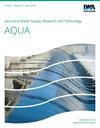Assessing drainage water quality for irrigation using the water quality index and DataFit software
IF 4.3
Q2 Environmental Science
引用次数: 0
Abstract
In this research, the quality of drainage water was studied by using the water quality index (WQI). Water samples were taken from the Al-Dujaila River and Al-Dujaila drainage. Drainage water was diluted to different ratios with river water to decrease its salinity and increase its potential for agricultural uses. The diluted samples contained between 0 and 100% drainage water, and between 100 and 0% river water, in 10% steps – i.e., 0:10, 1:9, 2:8, 3:7, 4:6, 9:1, 8:2, 7:3, 6:4, and 5:5. After dilution of water, chemical properties, ion activities, electrical conductivity (EC), soil reaction (pH), sodium (Na+), calcium (Ca+2), magnesium (Mg+2), and total dissolved solid (TDS)) were measured in the laboratory of the University of Wasit/College of Agriculture, for computing the drainage water quality index (DWQI), sodium adsorption ratio (SAR), exchangeable sodium percentage (ESP), and soluble magnesium percentage (Mg%). Mathematical models were generated to predict the DWQI using DataFit software, depending on the water's chemical properties, and to find the best dilution ratio, which was 9:1. Model 2 includes the DWQI with SAR, ESP that gave the best results (R2 = 99.99%, RE = 0.0007, MAE = 0.425, RMSE = 0.6, and SEE = 1.992). The diluted drainage water used in this study was not suitable for either irrigation or human use.利用水质指数和DataFit软件对灌溉排水水质进行评价
本研究采用水质指数(WQI)对排水水质进行了研究。水样取自Al-Dujaila河和Al-Dujaila排水系统。排水与河水按不同比例稀释,以降低其盐度,增加其农业利用潜力。稀释后的样品含有0 - 100%的排水,100 - 0%的河水,按10%的步骤-即0:10,1:9,2:8,3:7,4:6,9:1,8:2,7:3,6:4和5:5。水稀释后,在Wasit大学农学院实验室测定土壤化学性质、离子活度、电导率(EC)、土壤反应(pH)、钠(Na+)、钙(Ca+2)、镁(Mg+2)和总溶解固形物(TDS),计算排水水质指数(DWQI)、钠吸附比(SAR)、交换钠百分率(ESP)和可溶性镁百分率(Mg%)。根据水的化学性质,利用DataFit软件建立数学模型来预测DWQI,并找到最佳稀释比,该稀释比为9:1。模型2包含SAR、ESP的DWQI,结果最佳(R2 = 99.99%, RE = 0.0007, MAE = 0.425, RMSE = 0.6, SEE = 1.992)。本研究使用的稀释排水既不适合灌溉,也不适合人类使用。
本文章由计算机程序翻译,如有差异,请以英文原文为准。
求助全文
约1分钟内获得全文
求助全文
来源期刊
CiteScore
4.70
自引率
0.00%
发文量
74
审稿时长
4.5 months
期刊介绍:
Journal of Water Supply: Research and Technology - Aqua publishes peer-reviewed scientific & technical, review, and practical/ operational papers dealing with research and development in water supply technology and management, including economics, training and public relations on a national and international level.

 求助内容:
求助内容: 应助结果提醒方式:
应助结果提醒方式:


